By Dr. Alejandro Lucia and Mr. Andrew Wakelin
In this guest blog, we present self-reports of exercise accomplishments by McArdle patients. Glycogenosis type V (glycogen storage disease type V [GSD V], McArdle disease or myophosphorylase deficiency) is a relatively rare (e.g. prevalence of ~1/167,000 Spanish people) disorder of skeletal-muscle carbohydrate metabolism inherited in an autosomal recessive manner. Patients are unable to obtain energy from their muscle glycogen stores. As a result, they typically experience exercise intolerance in the form of reversible, acute crises of early fatigue and contractures, sometimes with rhabdomyolysis and myoglobinuria, which are triggered by static muscle contractions (e.g. lifting weights) or dynamic exercise (e.g. climbing stairs, brisk walking).
Exercise is the trigger for symptom occurrence in McArdle patients; as such, they tend to be averse to exercise and have often been advised by clinicians to refrain from exercise. There is no prospect of a definitive cure (e.g. genetic therapy) for this disease in the foreseeable future. However, regular, moderate-intensity aerobic exercise can be one of the best allies of patients.
Our aim in sharing these vignettes of patients’ ‘success stories’ is to motivate patients with McArdle disease, and educate clinicians. Some of these accounts are of people who have devised their own way to cope with the condition. Others have been guided by medical and exercise professionals. And yet others have learned from peer groups how to manage the condition. With ages ranging from 16 to 64, these patients show what can be achieved.
[Alejandro and Andrew are two authors of the BJSM Editorial The ‘McArdle paradox’: exercise is a good advice for the exercise intolerant ( Lucia A, Quinlivan R, Wakelin A, Martín MA, Andreu AL 2012), click here to read the article]
JC, age 16, Girona (Spain). PYGM genotype p.R50X/p.R50X.
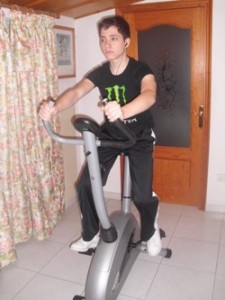
I was diagnosed at the age of 12, although I fatigued easily with physical activities since I was a kid. For this reason, I was always considered to be just a lazy guy. A cardiologist noticed I had very uncommon tachycardia at the start of an exercise treadmill test when I was 12. This prompted clinicians to do more studies on me, starting with a blood analysis that revealed very high CK levels.
Since diagnosis, I’ve been following a combined resistance (mostly light weight lifting) and aerobic program (cycle-ergometry) with increasing loads, under the supervision of an exercise physiologist. I take my sports drink before a weight-lifting session and I am especially careful with those exercises that I don’t practise regularly, e.g. swimming or skiing. These are the ones that can cause contractures. My CK levels have been stable in the last years (in the range of 1,500-3,000 U/L) and my muscle fitness has continued to rise gradually since diagnosis.
AW, age 62, Builth Wells (UK). PYGM genotype p.R50X/p.R50X.
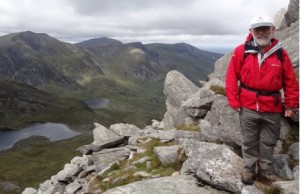
I had symptoms from age 4, always wanting to be carried on family walks. I could never manage school sports, was not picked for team games, was often frozen to the spot in tears of pain, frustration and humiliation. However, in teenage years a newspaper delivery round gave me an hour’s exercise every day at my own pace, resting whenever I needed – perfect for my developing muscles. I learnt that I could do a lot if I did it at my own pace in my own way. I undertook an “Outward Bound” course where I realised that my arms were affected a well as my legs (of course McArdle’s actually affects all skeletal muscle). I even climbed Mount Kilimanjaro, at 5,895 m.
I was finally diagnosed age 30, but received no advice for another 20 years. When at last I found a doctor who knew about McArdle’s I was able to put a name to the “second wind” that I had used since as early as I could remember. Using second wind and adopting techniques to avoid anaerobic activity I have climbed all 188 mountains in Wales over 600 m. I get the start of a muscle cramp about 10 times a day and try always to heed the warning in time. Yet a few moment’s lack of attention can lead to a fixed contracture – I have done it just putting on my walking boots. I aim to get no more than one or two a year, but the risk of a damaging muscle demand outside of my control is always there.
LB, age 64, New South Wales (Australia). Muscle biopsy, zero myophosphorylase.
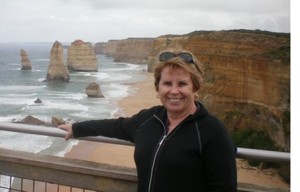
I have always struggled physically but somehow got through life despite the muscle pain and exhaustion. At age 60 I was diagnosed with polymyositis, put on steroids and told to avoid all exercise. After 18 months my condition had deteriorated so much that I could walk only about 20 m. I was convinced the diagnosis was wrong and, after a second muscle biopsy, was finally correctly diagnosed with McArdle Disease.
With no advice available in Australia, I started exercising again on my own initiative, pressing ahead despite the pain. Finding an on-line support group I learnt that was wrong. I started to keep within the aerobic phase and built up my distance to 3 km, walking only on the flat. Then in 2011, I joined a McArdle’s walking course in the UK, where I learnt to walk safely in the hills and completed a walk of 11 km with 430 m of ascent. I now have the confidence to tackle all kinds of terrain, I know how to handle my McArdle’s and look after myself. My motto now is “I’ve conquered mountains”.
SW, age 59, London (UK). PYGM genotype p.R50X/p.R50X.
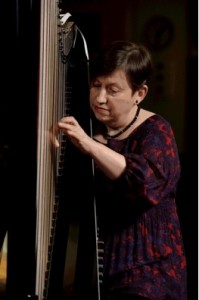
22 years ago, just after being appointed Principal Harpist of the BBC Symphony Orchestra, I was told ‘now you must conserve, not use, energy’, because I had ‘a very rare disease called ‘McArdle’s Syndrome’. At 37 years old, a diminutive 1.53 m tall, I had travelled the world with a mighty 47 kg instrument since the age of 18, so that came as a shock. After the initial panic, I decided that despite complaining of noticeable pains, exhaustion, and being told I was ‘unfit’ by about 30 doctors from a young age, my music had kept me going.
The benefit of slow, minutely detailed finger exercises and gradual build up of power, speed and strength, together with a relaxed and focused posture, enables me to do up to seven hours a day of practise. I have developed special playing techniques that suit my McArdle’s. It was difficult to accept that my repertoire has to be carefully chosen (very repetitive pieces are never going to be possible), but with a very healthy eating pattern, concentration, and passion for music with its healing affect on the emotions, I still lead an exceptionally active life in general.
SR, age 42, Toronto (Canada). PYGM genotype p.R50X/p.G135R.
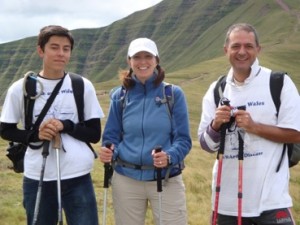
I was always keen on sports and running but could never understand why my performance didn’t measure up to that of my friends, despite doing more training than them. I was sure something was wrong but had no idea what it was. One day I was hit by a car whilst out running and was forced to take 18 months off all exercise. On starting exercise again one day I went swimming, suffered rhabdomyolysis and was hospitalised with CK of over 200,000 U/L.
Interest from a nephrologist led to a diagnosis of McArdle Disease in 2008 and finally I knew the answer to all those long-standing problems. I sought advice from other patients and gradually built up my fitness again. In 2010 I joined others in the “Walk over Wales” – 32 days, 340 km and numerous mountains. By walking with others I learnt about the dangers, how to recognise the signs of cramping, and about the techniques that can be employed. I now play ice hockey (with frequent breaks), practice yoga and am running again. My McArdle’s is a nuisance, but I can adapt and keep fit.
DA, age 22, Torrejón de Ardoz (Spain). PYGM genotype p.R50X/p.R50X.
I have McArdle syndrome, as well as septo-optic displasia and multiple hormone deficit. I fatigued easily during exercise in my childhood, but my teachers didn’t give it much attention. The first medical evaluations revealed that my CK levels ranged between 50,000 and 75,000 U/L. Upon diagnosis of McArdle Disease (some 6 years ago), I was clearly told by my clinician to refrain from exercise unless I wanted to end up in a wheelchair.
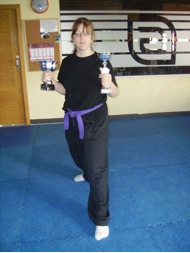
Thanks to the support and advice of a sports medicine specialist (with an expertise in exercise physiology), I started to follow a physically active lifestyle. I pedal on a cycle-ergometer for about an hour every day and I practice a martial art (Kajukenbo) with some success. I don’t experience dark urine and have no limitations during daily living, and my VO2 peak keeps going up. I take a sports drink before martial arts training sessions, because they are quite hard work. My dream is to become a Paralympic athlete, and I would like to let McArdle patients know how much they can benefit from exercise. I would like people with this and other rare disorders to use sports activities to help them become more socially integrated.